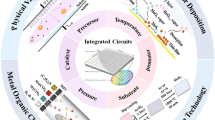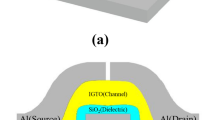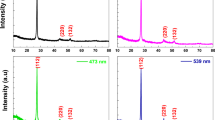Abstract
Tantalum Pentaoxide, an alternative to SiO2, as a high-k dielectric for DRAM and MOS applications, faces the problem of interface mismatch at silicon. SiO2 or Si3N4 interfacial layer could help in overcoming this problem. The higher band offsets of these materials also help in the reduction of leakage currents at low electric fields. Here we study the physical and electrical characteristics of Ta, oxidized in O2:NH3 ambient, and without any other interface layer. This is done to check if N/H moves to the interface, and thus improves the electrical properties. XRD studies of the film, showed the presence of Ta2O5. Peaks corresponding to TaSi2, un-oxidized tantalum and TaN were also found in the film. But the intensity of these peaks decreased with the reduction of NH3 content. Thus a higher oxygen content could reduce the content of TaN and unoxidized tantalum. FTIR analysis however showed strong Ta=O and Si-O peaks. For the MOS capacitors, due to the presence of resistive components, the maximum capacitance was reduced, compared to that of pure Ta2O5 films. Oxide charges in the films were observed to be around 1.9E10 cm-2. But the traps in these films were found to be almost negligible as observed from the negligible hysteresis in the C-V characteristics. Films with N/H showed lesser oxide charges by an order of magnitude, as compared to pure Ta2O5 films.
Similar content being viewed by others
References
W Neumueller, J Alsmeier, G Bronner, S Ishibashi, H Kiose, IBM Semiconductor Research and Development Center, Hopewell Junction, New York, (Aug 2000)
P. Gallias, J J Hantzpergue, J C Remy, D Roptin, Thin Solid Films, 165 (1988), pp. 237–241
T. Devoivre, C. Papadas, M Setton, 1999 Symposium on VLSI Technology, (1999) pp.131–132
H. Reisinger, G Steinlesberger, S Jakschik, M Gutsche, T Hecht, M Leonhard, U Schroder, H Seidl, IEDM 2001, pp.267–270
H. Jung, K. Im, D. Yang and H. Hwang, IEEE Electron Device Letters, Vol. 21, No.12, (2000), pp 563–565
E.P. Gusev, H. C. Lu, E.L. Garfunkel, T. Gustafsson, M.L. Green, IBM 1999
H. J. Lee, R. Sinclair, M B. Lee, H D. Lee, Journal of Applied Physics, 83(1), (Jan 1998), pp.139–144
F E Ghodsi, F Z Tepehan, G G Tepehan, Thin Solid Films, 295 (1997), pp.11–15
H. Ono, Y Hosokawaa, K Shinodaa, K Koyanagub, H Yamaguchib, Thin Solid Films, Vol 381, issue 1, (Jan 2001), pp.57–61
A. Pignolet, G M Rao, S B Krupanidhi, Thin Solid Films, 258 (1995), pp.230–235
Pallavi Krishnamoorthi and A N Chandorkar, Proceedings of the Eleventh International Workshop on the Physics of Semiconductor Devices, (2001), Vol 2, pp.1307–1309.
Author information
Authors and Affiliations
Rights and permissions
About this article
Cite this article
Krishnamoorthi, P., Chandorkar, A.N. Study Of Ta2O5 Based MOS Capacitors, With Tantalum Oxidized In O2:NH3 Ambient.. MRS Online Proceedings Library 716, _ (2001). https://doi.org/10.1557/PROC-716-B11.15
Published:
DOI: https://doi.org/10.1557/PROC-716-B11.15




